CHAPTER 6
NONLINEAR OPTIMIZATION
Previous chapters dealt with linear optimization, specifically linear programming and linear
integer programming. This chapter considers optimization problems that include a nonlinear
objective and/or nonlinear constraints, where the decision variables are real continuous variables
and both the objective and constraint functions are continuous and differentiable. The linear
programming problem is a special case of this problem.
We first discuss the unconstrained optimization problem, where we optimize an objective
function without any constraints and without any sign restrictions for the decision variables.
Then we will consider constraints restricting the variable values. These constraints may be either
strict equality constraints or inequality constraints. We will also consider sign restrictions for
variables. These problems are fundamentally different from the linear programming problem.
First, unlike linear programming, there is no systematic procedure that can solve all nonlinear
programming problems. Second, there may be local extremum points, which may not necessarily
be global solutions to the problem. Third, local optima may occur on the boundary of the
decision space or they may be interior points. Therefore, the convenience of searching an
optimum solution among the corner solutions of a feasible polytope, as in linear programming, is
lost immediately. This makes nonlinear programming problems much harder to solve than linear
programming problems. Here we will develop only the optimality conditions for these problems
and use those conditions to solve small scale example problems. In the following chapters we
will develop nonlinear market equilibrium models and risk programming models. There the
nonlinear programming optimality conditions will be utilized for understanding the properties of
optimum solutions and explaining why those models are appropriate tools for the purpose.
Nonlinear programming solution algorithms will not be covered.
6.1. Unconstrained optimization
This is the simplest nonlinear optimization problem. Suppose we have a function f:
which assigns a real number f(x) to each element
decision variables. When n=1, we have the univariate optimization problem, which can be stated
as Maximize f(x). Suppose x* is a solution of this problem. This means that
. Here x=(x1 , x2, ...,xn) is a vector of n
or
for any xx*. For xx* we have
arguments hold for a local minimum as well. Therefore, we obtain the first order necessary
condition for a local extremum:
. These two conditions imply that
. The same
6.1
nnx)x*()x(ff-*0f(x)f(x)0**)()(xxxfxf0*)(0**)()(lim*xfxxxfxfxx0*)(xf0=′*)x(f�
.
Theorem: If a differentiable function attains its local minimum or local maximum at a point x*,
then we have
Note that this is only a necessary condition since both for minimum and maximum we have the
same condition. In order to determine the nature of a critical point, i.e., x* where
, we
need to look at the second order derivative. The sufficiency condition is obtained from Taylor’s
theorem stated below:
Theorem: Suppose f is a twice differentiable function around a point x*. Then we can express the
function as a polynomial as follows:
is determined by the sign of the second derivative (here note that
is an error term which goes to zero faster than the rate x approaches to x*.
where
If x* is a critical point, the term including the first derivative vanishes, in which case the sign of
the difference
both ½! and (x-x*)2 are positive, and the second derivative term dominates the error term since
goes to zero faster than x approaches to x*). Therefore, if
, we have a local maximum,
we have a local minimum. This gives us the second order sufficiency condition:
and if
Theorem: If f is a twice differentiable function and
maximum occurs at x*. If
Note that we have strictly positive or strictly negative second derivatives in the above theorem. If
the second order derivative at x* is zero, we need to look at higher order derivatives. The above
theorem is extended as follows:
Theorem: If f is a differentiable function of order n or higher and n is the first higher order
derivative with
at a critical point x*, then a local maximum or local minimum occurs
, then a local minimum occurs at x*.
at a critical point x*, then a local
, then a local minimum occurs at x* and if
at x* if n is even. If
maximum occurs at x*. If n is odd, then x* is a saddle (or inflection) point, that is neither a
maximum nor a minimum occurs at x*.
Example: Suppose f(x) = x2 - 6x +1. Then
point.
Example: f(x) = x2 - 2ln(x).
namely x=1 and x= -1. Ignore x= -1 because the logarithm function is not defined at that point.
at any x, in particular at x=3, therefore x=3 is a local minimum.
= 2x - 6 = 0 implies x*=3. This is a critical
= 2x - 2/x = 0, or x2=1. Therefore there are two critical points,
a local
=2+2/x2 = 4 at x=1 . Therefore, this point is local minimum.
6.2
0=′*)x(f0=′*)x(ff(x)f(x*)0<′*)x(f(*)0fx0<′*)x(f0>′*)x(f0≠*)x(fn(*)0nfx(*)0nfx*)x(f′2=′*)x(f*)x(f′*)x(f′2*)*)((''!21 *)*)((' *)( )(xxxfxxxfxfxf�
implies 4x3 - 3x2 = 0 or x=0 or x=3/4. The second
Example: f(x) = x4 - x3 + 2.
derivative is 12x2 - 6x which is positive at x=3/4. Therefore, there is a local minimum at x=3/4.
However, at x=0, the second derivative is also zero. Therefore, we cannot determine the nature of
the critical point x=0 by using the second derivative test. The third derivative is 24x - 6 = -6 at
x=0. Since the first higher order derivative which is not zero is an odd order derivative, we have
a point of inflection at x=0.
can be determined. The same arguments can be extended to functions of several variables. The
only difference is that here we deal with partial derivatives instead of the ordinary univariate
derivative. This problem can be approached as follows. Suppose f:
is a multi-variate
function, and x*=(x*1 , .., x*i , ..., x*n) is an optimum solution. Then
function of one variable, namely xi, where all variables but xi are fixed at their optimum values,
i.e.
The above theorem and examples illustrate how a local extremum of a univariate function
for all
is a
. Then the optimum value of h must be obtained at
, therefore
. However,
is nothing but the partial derivative of f with respect to xi , i.e.
. This is true for all i. Therefore, the first order necessary optimality condition
in the case of multivariate functions is as follows:
Theorem: If
is a differentiable function (i.e., first order partial derivatives exist and
continuous) and there is a local extremum at x*, then
for all i.
The above theorem can also be stated in a more compact form as
vector of first order partial derivatives (called gradient) of f computed at x*.
In a similar way to the univariate case, the second order sufficiency conditions can be derived
from Taylor’s theorem. This requires second order partial derivatives and the Hessian of f at x*.
The latter is a symmetric matrix formed by the second order partial derivatives of f, i.e.,
, where
is the
.
Theorem: A twice differentiable function
can be represented as a polynomial around
6.3
()0fxn**1()(,... ,.., )iinhxfxxx*jjxxij≠*ix0=*)x('hi'hxiifh'(x*)(*)x:nf0=x∂∂*)(xfi0(*)x(*)x221212212............)(nnnxfxxfxxfxfxH:nf�
a point x* as follows:
, which means ‘approximately equal to’.
can be made arbitrarily small by selecting x sufficiently close to x*.
is the error term. We can state the above theorem without this term by replacing
where
The symbol
the strict equality with
Suppose x* is a critical point. Therefore, by the previous theorem the gradient term theorem
vanishes at x*. Then, the sign of f(x) - f(x*) is determined by the quadratic form defined by the
Hessian H. If H is a negative definite matrix, then the quadratic form is negative which means
that f(x) - f(x*) <0, or x* is a local maximum. If H is positive definite then x* is a local
minimum. If H(x*) is indefinite (in this case we can find different values of y for which the sign
of y′Hy can be negative, zero, or positive, where y=x-x*). This leads to the second order
sufficiency test:
Theorem: Suppose x* is a critical point of a twice differentiable function
is negative (positive) definite, then a local maximum (minimum) occurs at x* . If H(x*) is
negative (positive) semi-definite in a neighborhood of x*, again a local maximum (minimum)
occurs at x*. If H(x*) is indefinite, then x* is a saddle point.
Note the difference between the two statements in the above theorem. In the first case, we test
the strict definiteness of the function at the critical point x*. In the second case we test the semi-
definiteness not only at the critical point but also at any point in a small neighborhood of it.
Although the second condition is weaker, it has to be satisfied in an open set around x*, therefore
it may not be as practical as it seems.
Example: Suppose f(x,y,z)=x2 - xy + y2 - 3y + 2z2 -z. The first order optimality conditions are:
The solution of the above linear system is x=1, y=2, z=1/4. To determine the nature of this
critical point, form the Hessian and determine its definiteness. The Hessian at (1,2,1/4) (in
general at any point) is :
2x - y =0
-x + 2y -3 = 0
4z -1 =0
. If H(x*)
which is positive definite because all the leading principal minors of order 1, 2 and 3 are positive
(they are 2, 3, and 12, respectively). Therefore, a minimum occurs at this point.
6.4
*)*)((**)(21*)*)((*)()(xxxxHxxxxxxxfffε:nf400021012H�
Example: f(x,y) = 4x2 - 4xy + 2y2. The first order optimality conditions are:
the two conditions solved simultaneously give x=0 and y=0 as the only critical point. To
determine the nature of this critical point, form the Hessian and determine its definiteness. The
Hessian at (0,0) (in general at any point) is :
8x - 4y =0
-4x + 4y = 0
which is positive definite because the leading principal minors of order 1 and 2 are 8 and 16,
which are both positive. Therefore, a minimum occurs at this point.
In these two simple problems, the first order conditions are given by linear equations because the
objective functions are quadratic. When a non-quadratic objective function is involved, in
general a nonlinear set of equations arises and solving that set of equations may be a serious
problem itself. Nonlinear programming algorithms find the optimal solution (if exists and
unique) using iterative procedures, such as steepest ascend and steepest descend methods used to
solve a relative maximum or a relative minimum. This method is based on the concept of
directional derivative.
Definition: The directional derivative of f at a given point a in the direction of a unit vector u is
defined by
Example: Suppose
. To determine the directional derivative at (0,0,0) in the
direction of v=(1,-1,1), we first find the unit vector which has the same direction as the given
and denoted by Duf(a).
vector, (1,-1,1). Since
, the unit vector we need is
.
The gradient of
at (0,0,0) is (1,1,1). Therefore the directional derivative is:
This means that a slight movement (displacement) by tu from the point a in the direction of u
creates a change in the function value by about (0.577)t. For instance, if t=0.1, i.e. for the
displacement
, the change in the function value is approximately 0.0577.
Theorem: The maximum change occurs in the value of a function f when we move away from a
point a in the direction of the gradient vector (i.e. the directional derivative is maximum when u
6.5
4448H()f.auxyzf(x,y,z)e31)1(1222v)31,31,31(uxyzf(x,y,z)e577.031)31,31,31).(1,1,1(.uf)31.0,31.0,31.0(ut�
.
=
The above result is a direct consequence of an analytic geometry theorem which states that u.v =
, where
is maximum when
, the scalar product is largest if the two vectors are aligned. Therefore, the directional
is the angle between vectors u and v. Since
derivative will be maximum if the gradient vector and the direction vector have the same
direction (or the angle between them is zero). This result is particularly important in
optimization because it tells us that we would move in the direction of the gradient vector at any
point in order to achieve the highest gain in the value of the function that we want to maximize
(we choose the negative gradient direction if we want to minimize the function value). This
result is the basis of the steepest descend (and ascend) algorithms.
In light of the above theorem, the steepest descent algorithm (for minimization problems; if the
problem is a maximization problem we use the steepest ascend algorithm which uses the gradient
direction instead of the negative gradient direction used in the discussion below) is described as
follows. Starting with a given initial point x0 , determine the negative gradient direction
and move in that direction by an appropriate step size t so that the function value is
decreased at maximum amount. That yields a new point, say x1 . Repeat the process at x1 , i.e.
determine the negative gradient direction
and move in that direction by an appropriate
step size t so that the function value is decreased at maximum amount. This yields a new point,
say x2 . Iterate this way until the function value cannot be decreased further or the change that
can be obtained by another iteration is negligibly small. The points generated in two successive
steps of the algorithm can be described by the iterative equation:
xk+1=xk - t
where t is the step size at iteration k. The step size t at any step is determined by solving the
following univariate optimization problem:
Minimize {
(t) = f[xk - t
] }
The last point generated by this procedure is a relative minimum.
For a relative maximum, proceed in the gradient direction, rather than the negative gradient
direction, and use maximize instead of minimize in the above expression.
Here we will illustrate the workings of this algorithmic procedure using the second example
given above.
Example: f(x,y) = 4x2 - 4xy + 2y2. The gradient vector is (8x - 4y, - 4x + 4y). Let’s use x0=(2,3) as
the initial point (that is selected arbitrarily). At this point the gradient is (4,4). Therefore we
move in the direction of (-4,-4) to obtain x1=(2,3) + t(-4,-4)=(2-4t,3-4t). The optimum value of t
is obtained from the following minimization:
6.6
f()aθosv.uCθθosC0=θ0-f()x1-f()xkf()xφkf()x�
=(0,1)-t(-4,4)
Minimize
=(2,3) -1/2(4,4)=(0,1).
(t) =f(2-4 t, 3-4 t)=4(2-4 t)2 - 4 (2-4 t)(3-4 t) + 2 (3-4 t) 2
Equating the first derivative with respect to t to zero and solving for t, we get -16(2-4 t)=0. This
gives t=1/2 (note that this t value is a global minimizer since the second order derivative is
64>0). Therefore, the new point is x1 = x0 -t
At x1=(0,1), the gradient is (-4,4). Therefore, the new point will be x2=x1 - t
= (4t,1-4t). The optimum step size t is solved from :
which gives t=1/10=0.1 (again note that the second order condition is met). Therefore, the new
point is x2=(0,1)-0.1(-4,4) = (0.4, 0.6). At this point the gradient is (0.8, 0.8). Therefore, we have:
x3 = x2 -
solved from:
which gives t=1/2 and therefore x3 = (0, 0.2).
By these iterative steps we get closer and closer to (0,0), which is the global optimum solution of
the problem. For instance if we had done one more iteration, the gradient direction would be
(-0.8, 0.8) and we would get t=0.01 and therefore x4= (0.008, 0.192).
The first three points obtained by the steepest descend algorithm are shown in the figure below:
=(0.4, 0.6) - t3 (0.8, 0.8) = (0.4 - 0.8 t3, 0.6 -0.8 t3). The optimum value of t3 is
(t) =f(4t,1-4t))=4(4 t )2 - 4 (4 t)(1-4 t) + 2 (1-4 t)2
Minimize
( t) =f(0.4 - 0.8 t, 0.6 -0.8 t)
Minimize
6.7
φ0()fx1()fxφ2tf()xφX0=(2,3)X1=(0,1)X2=(0.4,0.6)X3=(0, 0.2)�
As may have been noticed, the direction vectors are perpendicular to each other. This is not a
coincidence. The steepest descend (or ascend) method always progresses in this way, i.e. always
finds perpendicular direction vectors to the previous direction vector.
Exercise: Solve the problem Maximize (
optimality conditions and then the steepest ascend algorithm (note that the problem is now
maximize, therefore use the gradient direction for determining a new point when approaching the
) using the first order and second order
optimal solution). The first approach should result in
. When using the steepest
ascend algorithm, start with
and generate the next five points [Answer:
,
,
,
,
,
]
6.2 Optimization with strict equality constraints
Nonlinear constrained optimization has fundamentally different properties than linear
programming in that the optimum solution can be an interior point or a boundary point. Even if
the constraints are linear, an optimum solution can occur at a boundary point which may not
necessarily be a corner solution (vertex). Therefore, as mentioned at the outset, the convenience
of linear programming, namely searching only the corner solutions and finding the best one, is
lost immediately. This is explained in the figure below. Suppose the solution space is the set of
points satisfying g(x)≤b, which are represented by all points below the graph of g in the figure.
Consider a given value of the objective function c and the set of all points x such that f(x)=c.
This set is called a level curve or an isoquant (such as an isoutility curve or a production or cost
isoquant). Three such level curves are shown in the figure. Suppose the nested closed curves
indicate higher isoquants and suppose we want to maximize f(x). Thus, the optimum solution of
the problem
would be the interior point shown by x1*. At a point like this all directions are feasible (if the
step size is small enough, i.e. we stay within the feasible region by taking a small displacement
vector in any given direction), and therefore the directional derivatives must all be zero. In
particular the partial derivatives must all be zero. However, the isoquants may be such that the
optimum point can be on the boundary of the feasible region, as indicated by the dashed
isoquants and the point x2*.
Max f(x)
s.t.
6.8
22xxyyy12*(,)33x0(1,1)x0(1,1)x11(,1)2x213(,)24x333(,)84x4311(,)816x51311(,)3216xg()bx�
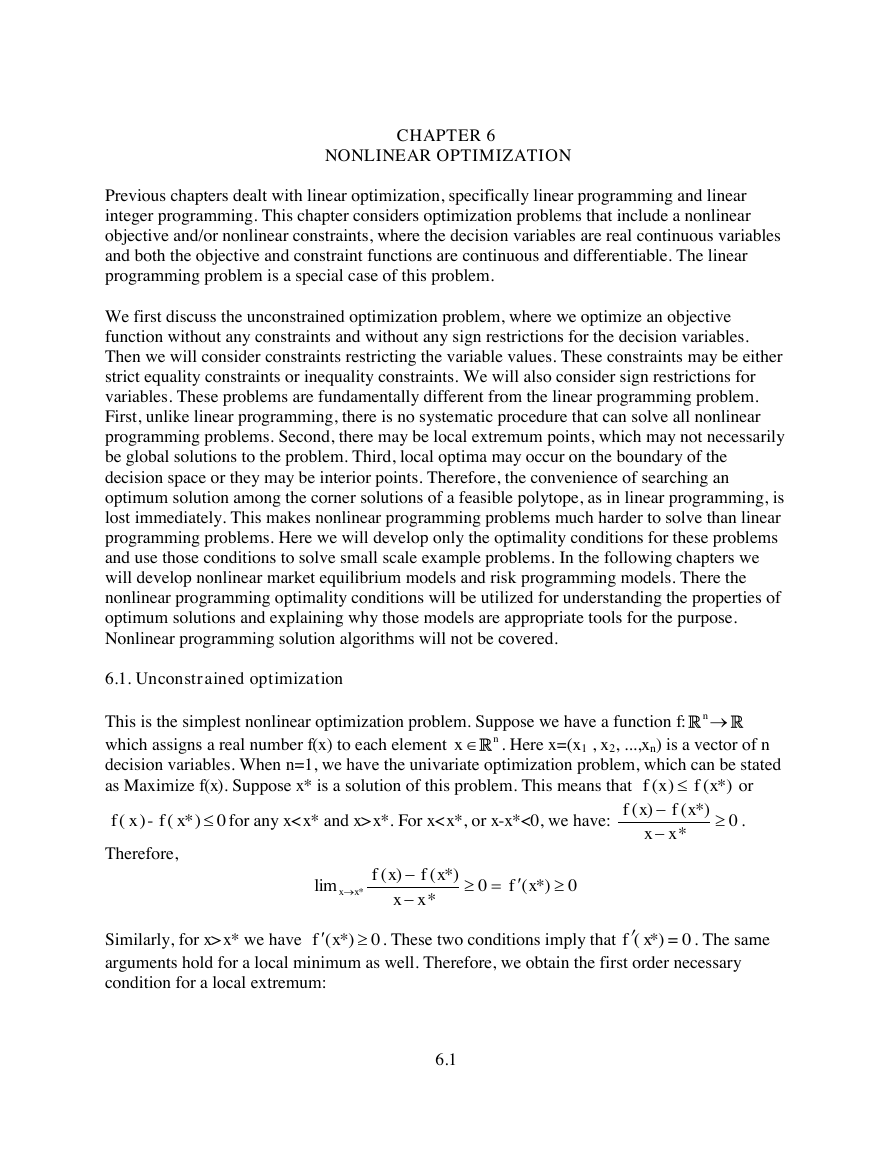


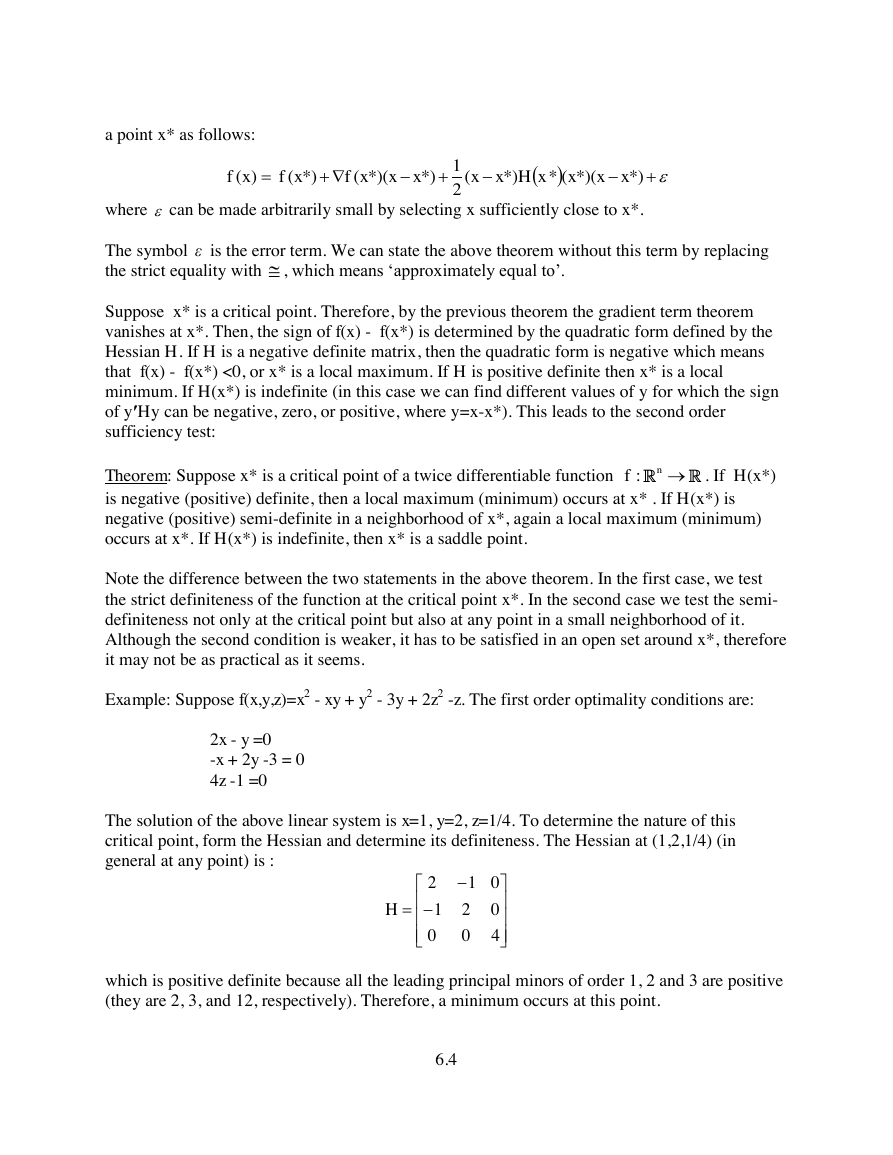
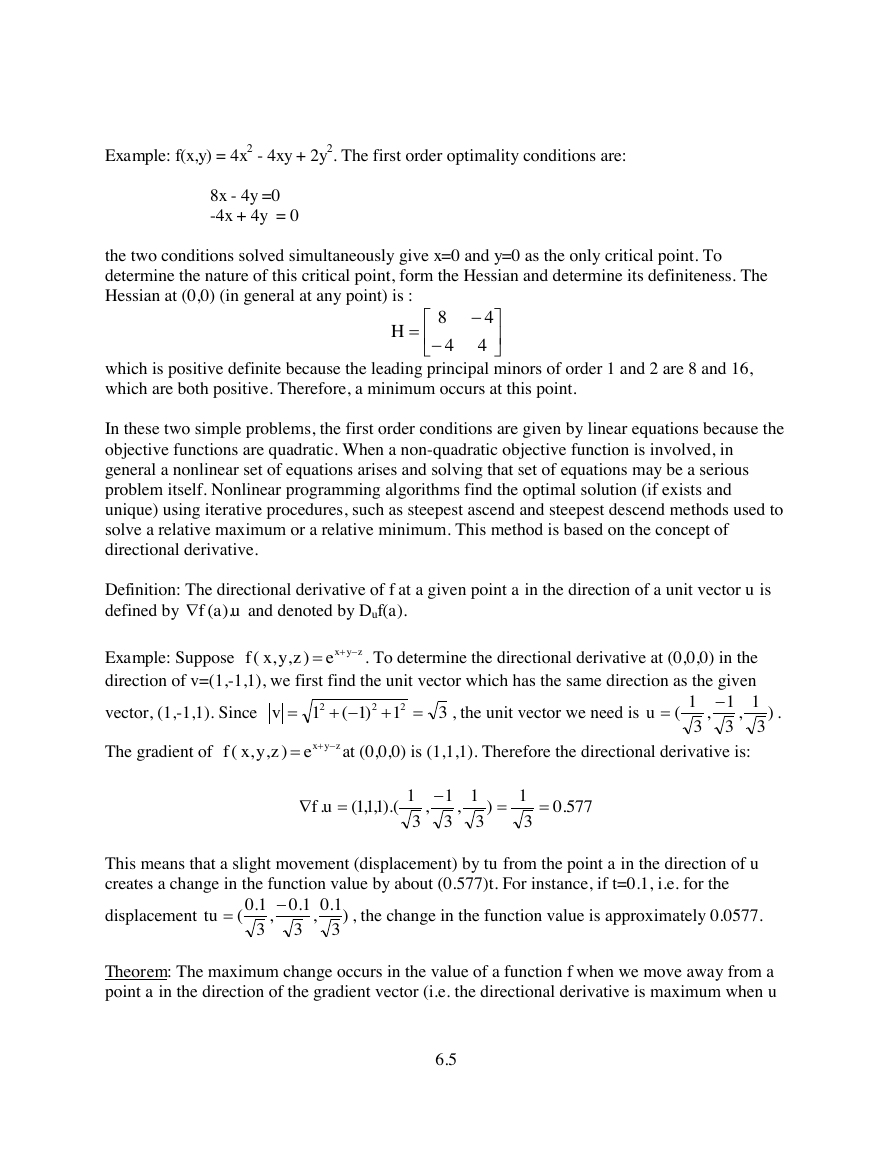
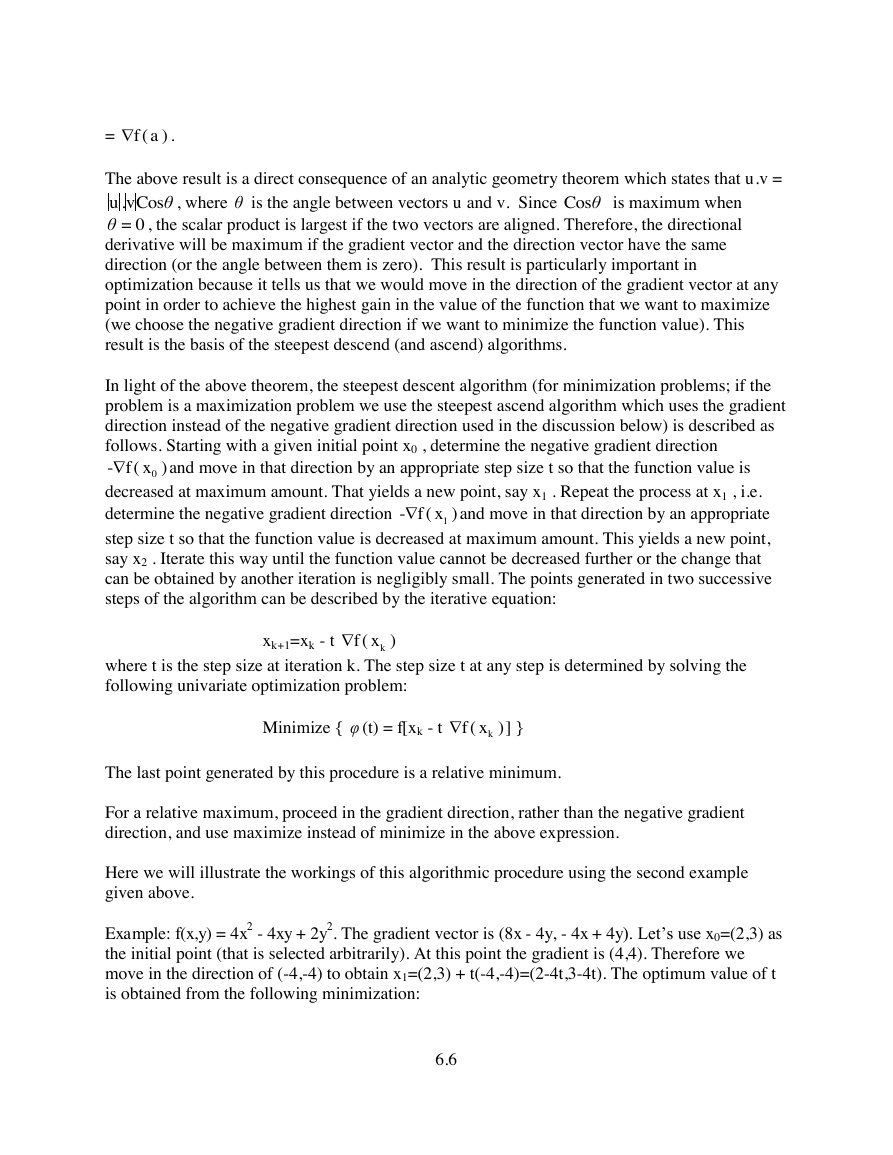
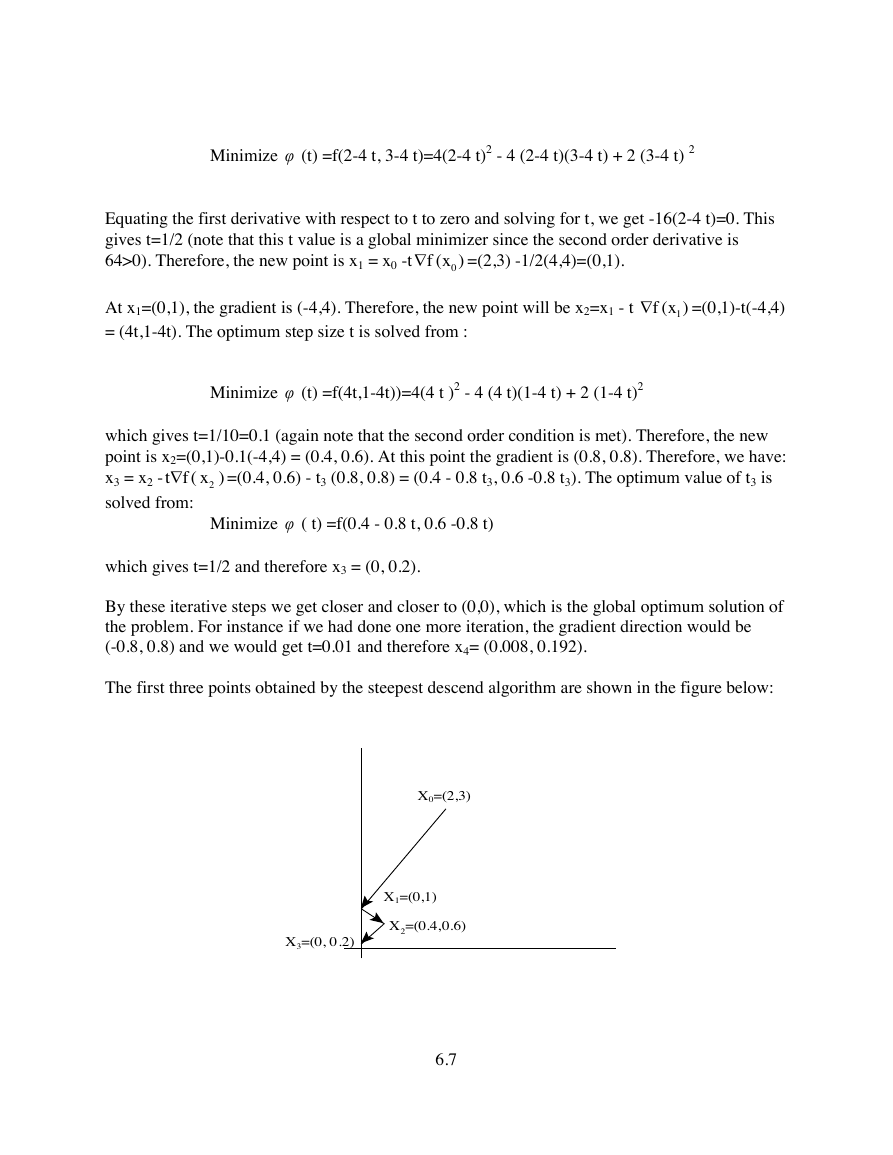
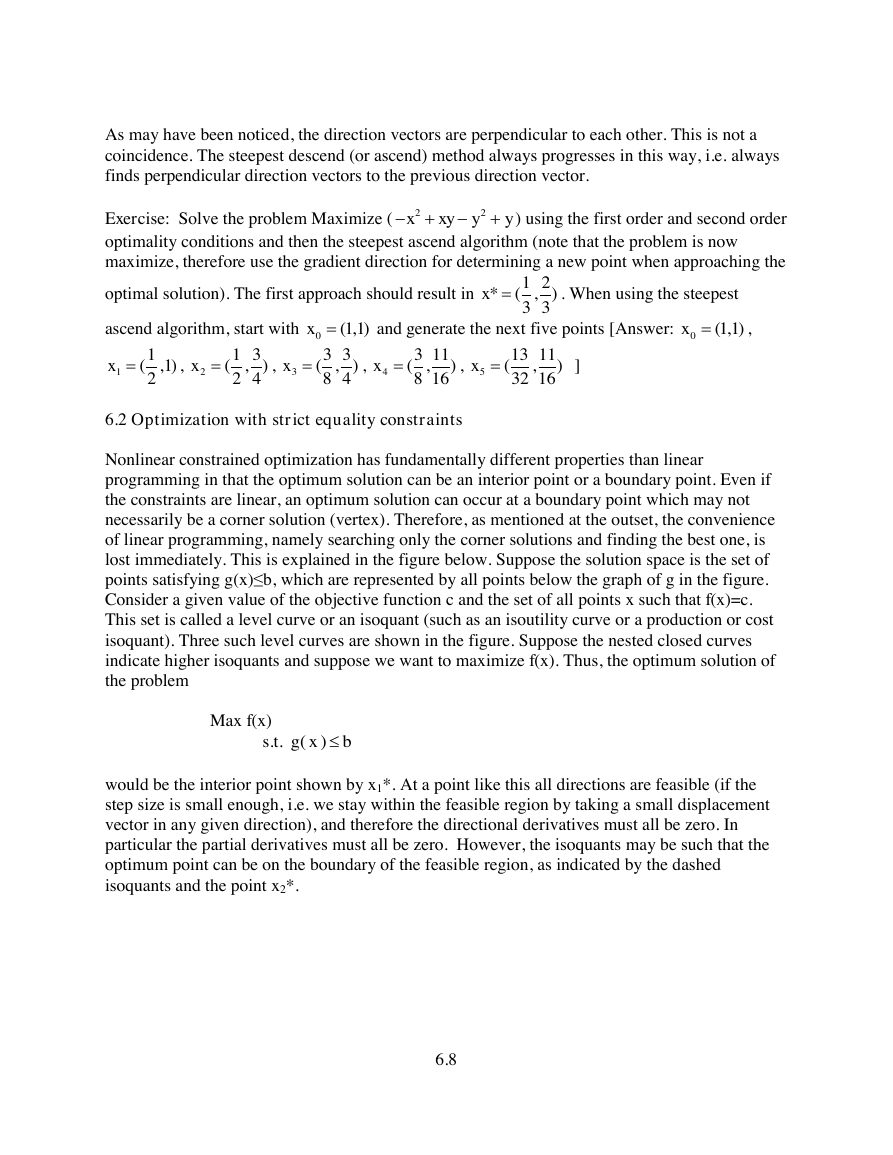








 2023年江西萍乡中考道德与法治真题及答案.doc
2023年江西萍乡中考道德与法治真题及答案.doc 2012年重庆南川中考生物真题及答案.doc
2012年重庆南川中考生物真题及答案.doc 2013年江西师范大学地理学综合及文艺理论基础考研真题.doc
2013年江西师范大学地理学综合及文艺理论基础考研真题.doc 2020年四川甘孜小升初语文真题及答案I卷.doc
2020年四川甘孜小升初语文真题及答案I卷.doc 2020年注册岩土工程师专业基础考试真题及答案.doc
2020年注册岩土工程师专业基础考试真题及答案.doc 2023-2024学年福建省厦门市九年级上学期数学月考试题及答案.doc
2023-2024学年福建省厦门市九年级上学期数学月考试题及答案.doc 2021-2022学年辽宁省沈阳市大东区九年级上学期语文期末试题及答案.doc
2021-2022学年辽宁省沈阳市大东区九年级上学期语文期末试题及答案.doc 2022-2023学年北京东城区初三第一学期物理期末试卷及答案.doc
2022-2023学年北京东城区初三第一学期物理期末试卷及答案.doc 2018上半年江西教师资格初中地理学科知识与教学能力真题及答案.doc
2018上半年江西教师资格初中地理学科知识与教学能力真题及答案.doc 2012年河北国家公务员申论考试真题及答案-省级.doc
2012年河北国家公务员申论考试真题及答案-省级.doc 2020-2021学年江苏省扬州市江都区邵樊片九年级上学期数学第一次质量检测试题及答案.doc
2020-2021学年江苏省扬州市江都区邵樊片九年级上学期数学第一次质量检测试题及答案.doc 2022下半年黑龙江教师资格证中学综合素质真题及答案.doc
2022下半年黑龙江教师资格证中学综合素质真题及答案.doc